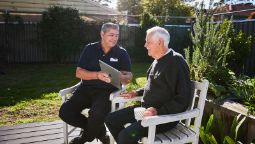Dealing with bloody taboos in advertising

Print advertising in women’s magazines has created a secret language to ensure the readers aren’t confronted with the monthly bloody reality of menstruation.
In summary
- Period product advertising over the past century has done everything in its power to deny the monthly bloody reality of menstruation
- Analysis for The Age by Dr Jane Connory, Lecturer in Communication Design, Swinburne University of Technology
There is no shortage of blood on our TV screens and streaming services. True crime shows analyse blood spatters and gruesome murders without any element of censorship. Medical shows broadcast surgeries and wounds in high definition, but it is rare that we are confronted with period blood in the media.
Period product advertising over the past century has done everything in its power to deny that period blood exists. Print advertising in women’s magazines has created a secret language to ensure the readers aren’t confronted with the monthly bloody reality of menstruation.
I analysed 100 period product advertisements from 100 years of Australian women’s magazines (1920-2020), and it wasn’t until 1974 that the word “period” was actually used. Periods were referred to as “liquids” or “fluids” and were given shameful euphemisms like “nature’s handicap”.
Until the 1950s, periods were referred to as medical problems and period products were also given codified names like “surgical appliances”. During World War II, pads were in limited supply because the materials used to manufacture them were instead used to make bandages for the war effort. But still, no blood to be seen.
In fact, rather than even seeing the colour red in most of these advertisements, you were more likely to see white. The advertising deals with this taboo by simply denying the vibrant colour has any association with the product. Women frolic happily in white bikinis, ride bikes in white shorts and strut down the street in white heels and pant suits.
By the 1980s, these advertisements might have had people convinced that pads and tampons were purchased to soak up inky blue liquids. Diagrams especially boasted of the absorbent nature of pads and tampons through the use of bright blue arrows and royal blue dots.
The packaging design in these print advertisements also denied the reality of periods. From 1960 to the present day we see large roses, daisies, leaves, cotton flowers and floral filigree on period product packaging. This delicately feminine metaphor for new life might be more appropriately symbolised by a prickly cactus – trust me!
It is understandable that you might feel very uncomfortable with this analysis as these ads model the secretive behaviours that keep periods taboo. Women are never shown to share their “secret” with men in these ads, nor do they dare mention a period at school or in the workplace. Periods can be mentioned only in hushed tones around other girlfriends and your mum in your bedroom or kitchen.

Period product advertising over the past century has done everything in its power to deny that period blood exists. Credit: Chloe Booker
As we reach another International Women’s Day next Monday, it is important that we begin to become aware of behaviours and messages that make this natural occurrence shameful. Yes, not all women have periods and some people who identify as non-binary also have periods, but denying their existence and promoting period shame leads to harm. Unhealthy sexual decisions, financial and professional discrimination, bullying and embarrassment can all stem from the stigma around periods.
The media and advertising industry have a huge influence on societal norms and addressing this taboo could have many positive effects. Some brands are attempting to do this but are often confronted with conservative customers trying to silence the reality. These attempts should not be thwarted but encouraged to continue eliminating the harmful taboo surrounding the depiction of periods.
This article is republished from The Age under a Creative Commons license. Read the original article.
-
Media Enquiries
Related articles
-

- Health
Half of Australians living in aged care have depression – psychological therapy could help according to new research
An evaluation of more than 40 years of research has found that psychological therapy offers a promising alternative to the overreliance on anti-depressants in aged care.
Wednesday 20 March 2024 -

- Science
- Health
Aussie-led international team develop groundbreaking new platform to fast-track lifesaving brain research
An international team led by Australian researchers has developed a groundbreaking platform that will transform neuroimaging data analysis worldwide.
Thursday 11 January 2024 -

- Health
Swinburne researchers to help reduce burden of cardiovascular diseases and diabetes across Europe
Public health experts from Swinburne University of Technology will see Australian research implemented throughout fifteen European countries as a part of the world’s largest health literacy program.
Thursday 14 December 2023 -

- Health
Swinburne's Distinguished Professor Richard Osborne awarded prestigious NHMRC 2023 Investigator Grant
The National Health and Medical Research Council has awarded Swinburne's Distinguished Professor Richard Osborne a coveted 2023 Investigator Grant.
Friday 15 December 2023 -

- Health
Less than three per cent of aged care residents access mental health services. A pilot initiative is giving the sector hope.
A transformative mental health initiative for aged care residents has been awarded a $600K grant from The Ian Potter Foundation.
Wednesday 20 December 2023

